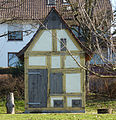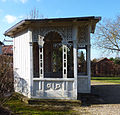Heilbronn Botanical Orchard
The botanical orchard in Heilbronn combines an arboretum of regional fruit trees and shrubs with school and show gardens and a collection of historical garden houses . It covers an area of 1.7 hectares and is located in the immediate vicinity of the Heilbronn Jewish Cemetery at the foot of the Wartberg . The garden on the street Im Breitenloch is open all year round with free admission.
history
The time of industrialization brought great social changes, many people became impoverished and neglected, especially children. In order to counter this, committed Heilbronn residents founded the poor welfare association in 1850 and a work center for boys in 1859. This moved to the area of today's orchard in 1900. Following the teachings of the Swiss pedagogue Johann Heinrich Pestalozzi (1746–1827) and other reform pedagogues, the theoretical transfer of knowledge at school was supplemented with practical work, particularly in handicrafts and horticulture . At that time Heilbronn was the first city in Germany to use this teaching method. After the association was dissolved in 1934, the area served the city of Heilbronn as a fruit farm and from 1965 as a tree nursery .
Since 1990 only the youth art school has been using the main building, the rest of the facilities threatened to be deserted and built over. In 1998 committed citizens again took the initiative and, on June 10, 1998, obtained a resolution from the city council to set up an "ecologically managed garden with an arboretum, school and show gardens" on the site. The Förderverein Garten- und Baukultur Heilbronn eV was founded in 2000 , which among other things wants to support the city in setting up a collection of historical garden houses and gazebos in the botanical orchard, building up the show garden with flowerbeds, looking after it and bringing it to life as part of a garden culture program to fill. The social history of the site is linked to the cooperation project between the Friends of Gardening and Building Culture and the Friends of the Pestalozzi School .
Stadtwerke Heilbronn financed the first construction measures as a compensation project for the construction of the Heilbronn Stadtbahn ; The association was able to make further investments as part of research projects and with the financial help of the City of Heilbronn, foundations and sponsors.
Garden areas and themes
Orchard
Orchards with carefully selected regional fruit trees, soft fruit trees and ornamental trees show the wealth of the southern German cultural landscape . In pruning courses and guided tours, visitors learn about fruit trees.
Flower beds
"Sun worshiper", "Romantic play of colors", "Light and shadow", "Hydrangea bed" and "Leaf and blossom" are working titles and program for the perennial plantings, especially in the edge areas of the eastern half of the garden. Annual summer flowers for the farm shop are grown in the cut flower field in the western park area right at the main entrance.
Show gardens
The Moorish Garden is the nucleus and centerpiece of the orchard, characterized by a music pavilion from 1877, a water basin and the plum blue, silver and rose plants. The beech grove , in the center of which is a small sandstone temple from around 1900, is characterized by red column beeches and perennials in creamy yellow and wine red. Crossroads, central roundabout, box hedges and the variety of flowers in the rural gardens characterize the cottage garden . The herb garden , bordered and structured by boxwood , lavender and rosemary hedges , offers visitors a wide variety of herbs and tea, but also shrubs and roses. In the school garden grow potatoes , corn , tomatoes and zucchini . The diverse flower beds and species-rich meadows of the botanical orchard offer insects rich sources of food.
Old, purposefully hewn stones such as boundary stones, fountain troughs, an atonement cross, a column are set up throughout the area - the orchard is also a lapidarium .
Garden houses and arbors
A total of 14 historical garden houses and arbors are gathered on the site, which could no longer be kept in their original locations and which have been moved and restored here. The construction period and style epochs stretch from the beginning of the 16th to the 20th century; their original builders belonged to very different social classes, from the upper class who had afternoon tea in their representative garden, to the winegrowers who needed a shed for their equipment to the allotment gardener who supplies himself with fruit and vegetables through his allotment garden .
At the entrance to the site on the left is a late classicist Biedermeier garden house from 1834. It comes from Güglingen , where it was originally located at Stockheimer Straße 21. The building has an octagonal floor plan. The door and floor are from the 1920s.
On the left side of the site there is also a colorfully painted wooden garden house, which comes from the garden of the Salinen Austria headquarters in Bad Ischl , and an octagonal arbor. This comes from Long Street in Schwäbisch Hall . It was built around 1880 presumably for wealthy citizens. The arbor has steps made of sandstone and is decorated with numerous sawn ornaments.
Also on the left side of the site is a vineyard house that was originally located on the Wartberg. Private vineyard houses of this type with a bench, a bucket for making a fire and a collection point for rainwater were typical for the region between 1890 and 1960. They replaced the larger, communal stone houses.
The oldest building in the collection is a vineyard house from Schwäbisch Hall. The building can be dated to the time around 1530 through wall paintings in the interior, but was built from even older building materials. It is located in the top left corner of the site and, unlike most of the other structures in the garden, cannot be reached via an official route. The roof space of the building is set up as a shelter for bats, there are also four beehives , a hornet box and two bumblebee boxes in this house. The building originally stood not far from the hamlet gate in Schwäbisch Hall. As former owners, people from the craftsmen's class are verified.
A Wilhelminian style garden house comes from the east of Heilbronn . It initially belonged to the master furrier Ludwig Kremmer, who gave it to a master shoemaker from the old town in 1929 so that he could build on his property elsewhere. The garden house stood on the lower Neckarsulm footpath until 2000, before it was moved to the botanical orchard. The Seitz arbor has a construction made of lined timber. It once stood on Kübelstrasse in Heilbronn.
On the right side of the orchard, as seen from the entrance, is a Moorish-style pavilion . It comes from the garden of the house at Gymnasiumstrasse 35 and was originally located behind the Heilbronn synagogue . Construction was approved in January 1877; The client was the businessman Wilhelm Scholl .
Below the Moorish pavilion stands a structure modeled on Greek temples on a piece of lawn. It has four Ionic columns with a surrounding architrave and a frieze with a toothed pattern. The building was built around 1900 for the medical council Dr. Gustav Wild built and originally stood at Haller Straße 7 in Heilbronn.
At the edge of the central courtyard has been the "Royal Vehicle Arbor" since June 2013: it is a part - about a third - of a 3rd class railway car of the Royal Württemberg State Railways from 1847. The car part was built in 1913 in Heilbronn-Böckingen by the engine driver Wilhelm Schmid built as a garden house and provided with a gable roof.
Another row of garden houses was set up below the central building that houses the art school for young people and the farm shop. Here you can see an allotment garden arbor from Heilbronn- Böckingen from 1911 and an allotment garden arbor from the end of the 19th century, which is much more elaborately designed and kept in ocher yellow and English red. This arbor also comes from Böckingen. A red wooden arbor was built in Heilbronn at the beginning of the 20th century. It was initially on Schmollerstrasse and later on Cäcilienbrunnenstrasse.
actors
The Förderverein Garten- und Baukultur Heilbronn eV was founded in 2000 and is the initiator and sponsor of the garden culture program in summer with markets, guided tours and seminars on the topics of garden design, floristry, fruit growing, cultural landscapes and agriculture. The Friends' Association has built up the collection of historic garden houses and gazebos and takes care of their maintenance.
The Pestalozzi School has been running a café in the former fruit warehouse since 2008. In cooperation with this school, the development association carries out a training project for the pupils. The Heilbronn Community Foundation has been supporting the training projects of the Friends of Gardening and Building Culture with the Pestalozzi School on the grounds of the orchard since 2009. Since 2019 the café has been operated as "Café Susanne" by the Susanne Finkbeiner School in Heilbronn.
In the farm shop, which is also initiated and supported by the gardening and building culture association, the flowers, leaves, grasses and twigs freshly harvested on the orchard grounds are processed according to individual wishes.
The main building is the seat of the youth art school, a department of the Heilbronn adult education center.
The green space office of the city of Heilbronn maintains the facility in cooperation with the friends' association and the district association of garden friends Heilbronn.
Web links
Individual evidence
- ↑ According to the own presentation of the Botanical Orchard, page on the history, on the website of the institution mentioned under the web links.
Coordinates: 49 ° 9 ′ 4.2 ″ N , 9 ° 14 ′ 5 ″ E















